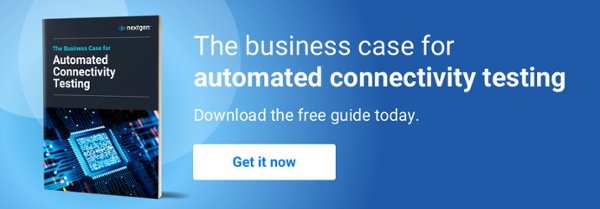Bluetooth and Wi-Fi Interoperability Testing: A Six-Point Checklist to Shape Your Strategy
Effective Bluetooth and Wi-Fi interoperability testing is now key to any successful product launch. It is a business critical activity. So it requires a strategic approach that reflects its importance to your company's continued growth.
Having a defined process can help you better manage risk and deliver better products, better customer experiences and better returns.
And with plenty of competition ready to challenge your position should things go wrong (Bluetooth SIG membership jumped 25% between 2015 and 2019 and is now approaching 36,000), it's never been more important to get the basics right from the start.
Consider how areas such as consumer electronics and industrial IoT are now dominated by interoperability. Smart connected homes, business technology and process automation are taking centre stage. Bluetooth LE, Wi-Fi 6 and Wi-Fi Mesh are helping to fuel a constant supply of new products and new use cases.
So now, more than ever, you need an intelligent, structured and streamlined testing strategy to ensure your ongoing success. Here are the six foundations:
1. Embrace the Opportunities Presented by Automation
With any significant technological advance, some people and companies can be apprehensive. But automated interoperability testing is not something to fear.
It isn’t here to put people out of jobs. It’s here to help everyone involved in the design and manufacture of connected technology to achieve better results and better devices operating in increasingly more complex use cases.
One of its biggest advantages is making previously impossible testing scenarios now a realistic ambition.
In warehouse or industrial settings, for example, Bluetooth Mesh is often used to network large numbers of lighting nodes. This is little surprise, given 90% of end product qualifications for Bluetooth Mesh are lighting focused. But it does mean automation is the only testing solution realistically capable of meeting the complexity demands in these testing scenarios.
Similar demands are found when testing Bluetooth LE broadcasting. Automation is the only way to achieve the necessary test coverage when permutations and simultaneous user scenarios expand. So be excited, not fearful.
2. Develop an Appropriate Device Library
Your testing is only as good as the devices with which you test your own product, so you need access to the devices with which your product is likely to operate. That means researching specific in-market products, as well as considering device age and regional availability differences.
Setting aside appropriate resources - both in terms of finances and man hours - is key to developing a successful device library. For businesses who do not want to get directly involved in developing and managing a device library, responsibility for this can also be outsourced to specialist interoperability testers.
Ultimately, the important thing is having access to an appropriate device library - without this any interoperability testing strategy cannot be as effective as it could be.
3. Budget for the Best Interoperability Testing Tools
Upfront investment in leading analysis tools and automation platforms saves you time, effort and stress when problems are discovered. These logs and traces help to quickly pinpoint problems, leading to faster resolutions and greater confidence that your product is robust and ready.
Remember, training is also key. Engineers need more than just tools: they need the expertise to be able to interpret, analyse and compare different data sets. Up-to-date knowledge is essential for successfully debugging products, and upskilling human engineering resources in this way is the perfect complement to automation by using the resources gained to increase the overall effectiveness of your team.
4. Continue to Test Throughout the Product’s Lifecycle
Pre-launch testing isn’t enough, especially in today’s fast-paced world where device releases happen at lightning-quick speeds. To ensure continued user satisfaction, you must maintain ongoing interoperability between your device and others as new products are released.
You will likely need to develop a strategy on two fronts: in-market testing and firmware updates. This double-pronged approach is the only safe way to minimise the risk of costly reputational impacts and reduced customer loyalty.
5. Be Transparent With Your Testing Results
Build trust in supporting your product through its lifecycle by publishing your interoperability testing results.
This may feel like a daunting step. However, being open with your data - no matter who is at fault - will build loyalty and goodwill with your customers.
It will also help users to more quickly fix or understand problems they are encountering that are not the fault of your device. When your customers know where the issues lie, then they know where to request support.
6. Take Advantage of Testing Events
Testing events like the Bluetooth UnPlugFests are perfect for getting quick insights into your product’s interoperability performance. They also enable you to view future third-party product releases and learn how they will interact with your current or future devices.
If your engineering or QA team is proactive in attending these in-person events, you are likely to gain a significant competitive advantage. Knowledge of your own products will dramatically increase. But so too will your understanding of where the market is moving and what devices are coming soon.
A Smart Approach to Bluetooth and WI-FI Interoperability Testing
Devising a Bluetooth and Wi-Fi automated interoperability testing strategy will pay dividends for years to come.
Both Bluetooth and Wi-Fi are set to continue to play major roles in the next generation of connected devices. So being confident in your organisation’s testing processes will help you to design and deliver your next products successfully.
To speak to a Nextgen expert about how you can create better connected products with automated interoperability testing, contact us today.




